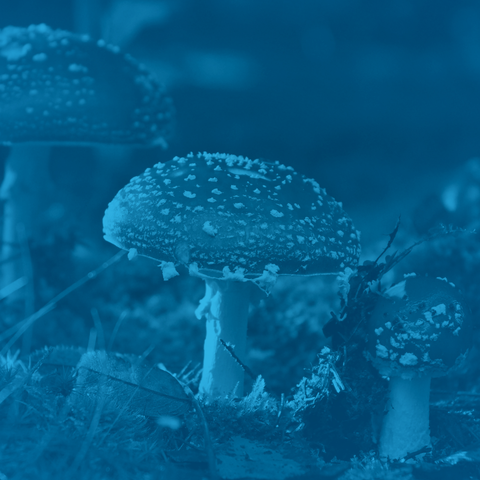
The fly agaric or fly amanita (Amanita muscaria) is a widely distributed mushroom found throughout Continental Europe and the United Kingdom [1]. It is perhaps one of the most easily recognizable mushrooms, with its scarlet cap dotted with conical white fleecy scales. The fly amanita favors an acidic environment such as birch forests. It is most prevalent in late summer or autumn.
The mushroom's common name suggests that it was used to kill flies until this purpose was superseded by arsenic. The bioactive compounds in the mushroom were a mystery for a long time until several hallucinogens were isolated from it [1-3]. Traditionally, the shamans of Eastern Europe used it as an inebriant and hallucinogen, but more recently, the mushroom and its compounds have garnered renewed interest [4].
All known subtypes of the mushroom, as well as its related species Amanita pantherina, are widely considered inedible due to their consumption causing a set of symptoms called "pantherina-muscaria syndrome" [5]. This syndrome manifests itself with various effects on the central nervous system, occurring roughly 30-60 min after eating the mushroom. Symptoms may include drowsiness, euphoria, and dizziness, with occasional nausea and vomiting also reported. Most cases of this syndrome are resolved within 24 hours with little more than supportive care and with no clinical evidence of liver damage, acute kidney injury, or other lasting symptoms after the intoxication has passed [6].
Despite the undoubted neurotoxicity and dissociative effects of the fly amanita, there are several bioactive compounds contained within it that are being examined for their potentially beneficial effects on health. Recent work has investigated the effects of selected compounds on lung cancer cells, for example [5], and there are suggestions that extracts from fly amanita may be used in the treatment of neurodegenerative diseases such as Alzheimer’s as well as cerebral ischemia [7].
This article will look at three important compounds found in the fly amanita mushroom and provide information on their effects and potential benefits for health. If you'd like to learn more about the fly agaric mushroom and its interesting history, read here and here.
Agarin
Agarin (also known as muscimol or pantherine) is a colorless crystalline substance that is readily soluble in water but not in alcohol or organic solvents. It was discovered by Danish and Australian neurochemists and has since been used extensively as a ligand to probe gamma-aminobutyric acid (GABA) receptors and assist in the development of GABAergic agents [8].
As a selective agonist of GABA receptors [9], agarin is a conformationally restricted derivative of GABA. The binding of agarin to the GABA receptors blocks the neuronal and glial reuptake of GABA, increasing serotonin and acetylcholine levels and lowering norepinephrine. Like GABA, agarin is an inhibitor of central nervous system neurotransmission and has been shown to reduce reaction time in a dose-dependent manner when microinjections of it were administered to animals [10] and has shown promise as an anticonvulsant [11] and anticancer compound [12].
Agarin has dose-dependent effects with higher doses leading to significant, but reversible, central nervous system symptoms. Its toxicity seems to be low when used in controlled environments, with no long-term damage observed in animal studies and human cases resolving without severe outcomes.
Agarin is one of the main ingredients of Tro Zzz, our buccal troche formulated for sleep! It is present in a safe, low dosage (1 mg per troche) and binds to GABA receptors in the brain, increasing GABA neurotransmission!
Ibotenic Acid (Ibotenate)
Ibotenic acid, also called ibotenate, is a naturally occurring compound with psychoactive properties that structurally resembles glutamic acid. Alongside agarin, they represent the most active substances in the fly amanita that are responsible for its psychoactive effects [13]. Ibotenic acid is decarboxylated to agarin, which is structurally similar to GABA. These two compounds are the main cause of the psychotropic effects after mushroom ingestion, with agarin accounting for the greater part, because its psychoactive dose is 10 times lower than that of ibotenic acid [14].
Ibotenic acid is an agonist of glutamate, thus inducing an excitatory effect on the central nervous system. These different actions are supported by the different syndromes observed in patients after the intoxication with A. muscaria and A. pantherina. Confusion, agitation, and euphoria are the main tendencies in the case of A. muscaria, in which ibotenic acid is present in higher concentrations than agarin, and somnolence and comatose in the case of A. pantherina, in which agarin is the major compound [15].
Muscarine
First discovered in 1869, muscarine was initially thought to be the main psychoactive compound in the fly amanita but is only found in trace amounts compared with other poisonous fungi.
Muscarine is a selective agonist of muscarinic acetylcholine receptors, thus mimicking the action of acetylcholine and giving the receptors their name. It exhibits a range of actions on various neurons and endocrine cells [15]. It acts on muscarinic acetylcholine receptors in the parasympathetic nervous system. The nerves of this system encompass smooth muscles and glands and therefore it has a direct influence on a variety of organs. Its action is tied to the “rest and digest” system, comprising sexual arousal, salivation, lacrimation, urination, digestion, and defecation.
Unlike agarin and ibotenic acid, this compound is unable to cross the blood-brain and blood-cerebrospinal fluid barriers, therefore preventing any potential effects on the acetylcholine receptors of the central nervous system. Although it is present in trace amounts (0.02% dry weight) in the basidiocarps (which include the fly amanita), muscarine is notably responsible for the autonomic aspects of the symptoms associated with mushroom consumption, such as perspiration, hypersalivation, lachrymation, bradycardia, diarrhea, and fatigue. Higher concentrations of muscarine are reported in mushrooms belonging to the genera Inocybe, Inosperma, and Pseudosperma.
Although there is a lack of research on the metabolism of muscarine in the human body, muscarinic agonists are used as drugs to treat an array of conditions.
Summary
This article has presented information on the most significant compounds present in the fly amanita mushroom, highlighting the potential range of neuroprotective, cytoprotective, hepatoprotective, and other effects that might be available to biomedicine in the future. The potential for adverse effects emphasizes the need for supervised and cautiously designed studies with careful administration of the active compounds present. Mycotherapy nevertheless seems to be a promising territory for the scientific community through leveraging naturally occurring compounds against important and challenging health conditions.
References
[1] M.R. Lee, E. Dukan, I. Milne, Amanita muscaria (fly agaric): from a shamanistic hallucinogen to the search for acetylcholine, J R Coll Physicians Edinb 48 (2018) 85–91. https://doi.org/10.4997/JRCPE.2018.119.
[2] D. Michelot, L.M. Melendez-Howell, Amanita muscaria: chemistry, biology, toxicology, and ethnomycology, Mycol Res 107 (2003) 131–146. https://doi.org/10.1017/s0953756203007305.
[3] K. Tsujikawa, H. Mohri, K. Kuwayama, H. Miyaguchi, Y. Iwata, A. Gohda, S. Fukushima, H. Inoue, T. Kishi, Analysis of hallucinogenic constituents in Amanita mushrooms circulated in Japan, Forensic Sci Int 164 (2006) 172–178. https://doi.org/10.1016/j.forsciint.2006.01.004.
[4] M. Ordak, A. Galazka, T. Nasierowski, E. Muszynska, M. Bujalska-Zadrozny, Reasons, Form of Ingestion and Side Effects Associated with Consumption of Amanita muscaria, Toxics 11 (2023) 383. https://doi.org/10.3390/toxics11040383.
[5] A. Dushkov, Z. Vosáhlová, A. Tzintzarov, K. Kalíková, T. Křížek, I. Ugrinova, Analysis of the Ibotenic Acid, Muscimol, and Ergosterol Content of an Amanita Muscaria Hydroalcoholic Extract with an Evaluation of Its Cytotoxic Effect against a Panel of Lung Cell Lines In Vitro, Molecules 28 (2023) 6824. https://doi.org/10.3390/molecules28196824.
[6] M.J. Moss, R.G. Hendrickson, Toxicity of muscimol and ibotenic acid containing mushrooms reported to a regional poison control center from 2002-2016, Clin Toxicol (Phila) 57 (2019) 99–103. https://doi.org/10.1080/15563650.2018.1497169.
[7] M. Voynova, A. Shkondrov, M. Kondeva-Burdina, I. Krasteva, Toxicological and pharmacological profile of Amanita muscaria (L.) Lam. – a new rising opportunity for biomedicine, PHAR 67 (2020) 317–323. https://doi.org/10.3897/pharmacia.67.e56112.
[8] G.A.R. Johnston, Muscimol as an ionotropic GABA receptor agonist, Neurochem Res 39 (2014) 1942–1947. https://doi.org/10.1007/s11064-014-1245-y.
[9] G.A.R. Johnston, Muscimol as an ionotropic GABA receptor agonist, Neurochem Res 39 (2014) 1942–1947. https://doi.org/10.1007/s11064-014-1245-y.
[10] A. Schmied, M. Amalric, J.F. Dormont, D. Farin, GABAergic mechanisms in the cat red nucleus: effects of intracerebral microinjections of muscimol or bicuculline on a conditioned motor task, Exp Brain Res 81 (1990) 523–532. https://doi.org/10.1007/BF02423501.
[11] R.C. Collins, Anticonvulsant effects of muscimol, Neurology 30 (1980) 575–581. https://doi.org/10.1212/wnl.30.6.575.
[12] M. Tatsuta, H. Iishi, M. Baba, H. Uehara, A. Nakaizumi, H. Taniguchi, Protection by muscimol against gastric carcinogenesis induced by N-methyl-N’-nitro-N-nitrosoguanidine in spontaneously hypertensive rats, Int J Cancer 52 (1992) 924–927. https://doi.org/10.1002/ijc.2910520616.
[13] K. Stebelska, Fungal Hallucinogens Psilocin, Ibotenic Acid, and Muscimol: Analytical Methods and Biologic Activities, Therapeutic Drug Monitoring 35 (2013) 420–442. https://doi.org/10.1097/FTD.0b013e31828741a5.
[14] J. Stříbrný, M. Sokol, B. Merová, P. Ondra, GC/MS determination of ibotenic acid and muscimol in the urine of patients intoxicated with Amanita pantherina, Int J Legal Med 126 (2012) 519–524. https://doi.org/10.1007/s00414-011-0599-9.
[15] Q. Carboué, M. Lopez, Amanita muscaria: Ecology, Chemistry, Myths, Encyclopedia 1 (2021) 905–914. https://doi.org/10.3390/encyclopedia1030069.





Comments (0)
There are no comments for this article. Be the first one to leave a message!